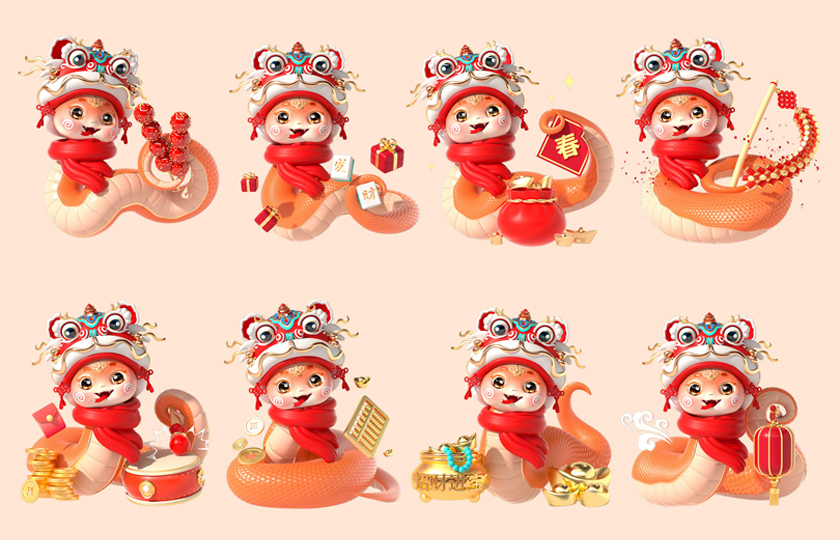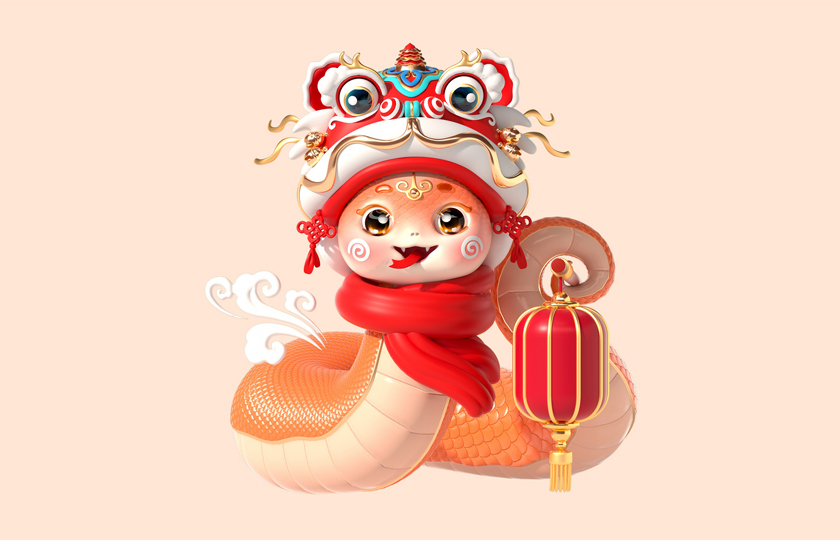Exploring the Zodiac: Discover Which Animal Rules the New Year 2025

As a food blogger who travels the world and shares recipes from different cultures, I have always been fascinated by the fusion of culture and cuisine. This year, while preparing a special feature for the New Year, I was drawn to the Chinese zodiac and became curious about which zodiac animal will usher in the New Year of 2025. With this spirit of exploration, I delved into the cultural significance of the Chinese zodiac. Now, let me share my findings with you.
The zodiac sign for the New Year 2025 is the snake
In China's zodiac chronology method, the zodiac signs appear in a cycle of 12 animals. In sequence, they are rat, ox, tiger, rabbit, dragon, snake, horse, sheep, monkey, rooster, dog, and pig.
The zodiac sign for 2024 is the dragon. According to the sequence, 2025 is the year of the snake. This chronology method has a long history. It is closely related to the heavenly stems and earthly branches chronology. In the heavenly stems and earthly branches chronology, there are heavenly stems and earthly branches.
In fact, the 12 zodiac signs correspond to the 12 earthly branches. Starting from zi (rat) and ending with hai (pig), it cycles repeatedly and is an important part of Chinese traditional culture.
Chinese Zodiac Signs Meaning
Each of the Twelve Chinese Zodiac Signs has its own unique symbolism and rich cultural significance:
Rat:
Symbolism: Cleverness, adaptability, thriving in adversity, and prosperity through offspring. The rat represents wealth, as it is believed to attract and hold onto treasures. Its strong reproductive capacity symbolizes continuity and flourishing.
Cultural Significance: In folklore, the rat symbolizes spirituality, wealth, and abundant offspring. Stories like "The Rat's Marriage" are widely told.
Ox:
Symbolism: Diligence, simplicity, sincerity, resilience, and strength. The ox embodies honesty, hard work, and the promise of a bountiful harvest.
Cultural Significance: In ancient myths, the ox often appears as a symbol of wealth and prosperity. It also represents health and vitality, as oxen are generally robust and rarely fall ill. In modern times, the term "niu ren" (牛人) is often used to describe exceptionally talented individuals.
Tiger:
Symbolism: Courage, boldness, and justice. The tiger is seen as a symbol of strength and is associated with good fortune and protection from evil.
Cultural Significance: The image of the tiger was often painted on doors to ward off evil spirits and protect families. It also signifies the arrival of spring and vitality.
Rabbit:
Symbolism: Gentleness, purity, intelligence, and kindness. The rabbit is associated with longevity and good fortune.
Cultural Significance: Rabbits symbolize abundance and fertility. They are often viewed as auspicious figures, as reflected in poetry that celebrates their joyful presence, such as "In the moon, Chang'e dances; on Earth, the Jade Rabbit heralds spring." Additionally, the rabbit represents cleverness, as shown in the idiom "Cunning rabbit has three burrows."
Dragon:
Symbolism: Nobility, ambition, adaptability, and expansiveness. The dragon symbolizes good luck and represents the authority of rulers.
Cultural Significance: In traditional Chinese culture, dragons are believed to control wind and rain and symbolize abundance and prosperity. Their image is prevalent in various art forms, including painting, sculpture, and architecture. Every dragon year is treasured, as it is thought to bring good luck.
Snake:
Symbolism: Beauty, passion, wisdom, and flexibility. The snake represents intelligence, adaptability, and resilience.

Cultural Significance: In traditional Chinese culture, snakes are regarded as "small dragons" and symbolize good fortune and wealth. Their intelligence is evident in their hunting strategies, while their flexibility and resilience enable them to thrive in harsh environments.
Horse:
Symbolism: Strength, loyalty, and courage. The horse signifies perseverance and vitality.
Cultural Significance: Horses symbolize loyalty, bravery, and power. They represent a positive spirit and the courage to move forward. In ancient society, horses were vital for transportation and warfare.
Goat (or Sheep):
Symbolism: Kindness, compassion, and purity. The goat represents prosperity and harmony.
Cultural Significance: In traditional Chinese culture, goats are seen as symbols of good fortune and purity. They are associated with abundance, as they provide meat and dairy products.
Monkey:
Symbolism: Intelligence, agility, and loyalty. The monkey embodies cleverness and joy.
Cultural Significance: Monkeys are seen as symbols of wit, intelligence, and bravery. They are often associated with happiness and celebration, appearing in various festive occasions.
Rooster:
Symbolism: Bravery, ambition, and protection. The rooster represents stability and harmony.
Cultural Significance: Roosters symbolize auspiciousness and safety in traditional Chinese culture. They embody a spirit of courage and resilience, often depicted in festive decorations to invite good luck.
Dog:
Symbolism: Loyalty, bravery, and intelligence. The dog represents security and peace.
Cultural Significance: Dogs symbolize fidelity and bravery in traditional Chinese culture. They are often portrayed as loyal protectors and courageous warriors in folklore.
Pig:
Symbolism: Generosity, humility, and contentment. The pig signifies abundance and prosperity.
Cultural Significance: In traditional Chinese culture, pigs symbolize good fortune and wealth. They represent a diligent, kind, and contented life, often associated with prosperity and abundance in folklore.
What is the Lucky Animal for 2026?
The year 2026 is the Year of the Fire Horse (丙午年) in the Chinese lunar calendar, which corresponds to the Horse in the zodiac.
People born under the sign of the Horse are typically enthusiastic, cheerful, and lively. They are warm-hearted and quick-witted, possessing strong insight and a keen sense of justice. They clearly distinguish between right and wrong and have their own ideas and pursuits, making them less susceptible to the influence of others.
Of course, an individual's personality is also shaped by various factors, such as family background and education, so these traits may not apply universally. If you're interested in zodiac culture, you might want to explore more about the fortune and characteristics of those born in the Year of the Horse.
Differences Between Chinese Zodiac and Western Astrology
1. Origin and Cultural Background
Chinese Zodiac: Originating from ancient China, it evolved from the principles of yin and yang and the five elements, along with ancient timekeeping methods (the sexagenary cycle). It is deeply rooted in Chinese philosophy, folklore, and traditional practices, reflecting ancient astronomical knowledge, animal worship, and folk beliefs.
Western Zodiac: Emerging during the Babylonian era, it is based on the ecliptic, which divides the sun’s annual path into twelve equal segments of about 30 degrees each, corresponding to a zodiac sign. Western astrology focuses more on the zodiac sign linked to an individual's birth date, along with inferred personality traits and fortunes, drawing heavily from astronomical observations and mythology.
2. Classification Criteria
Chinese Zodiac: Determined by the year of birth, with a twelve-year cycle repeating itself. For example, both 1988 and 2000 are the Year of the Dragon, meaning people born in these years share the Dragon sign.
Western Zodiac: Classified by birth date, specifically determined by the sun's position along the ecliptic. Each sign corresponds to a specific time period, such as Aries (March 21 to April 19) and Taurus (April 20 to May 20).
3. Symbolic Meaning
Chinese Zodiac: Each sign is associated with a terrestrial branch, paired with a heavenly stem, forming the basis of the Chinese calendar. Each animal has unique characteristics and symbolism, such as the cleverness of the Rat, the diligence of the Ox, and the bravery of the Tiger.
Western Zodiac: Each sign has its own unique symbolism and associated stories from astronomy, like Aries representing adventure and courage, while Taurus symbolizes stability and patience. The names and meanings of zodiac signs often derive from figures and creatures in Greek mythology.
4. Application Fields
Chinese Zodiac: Closely linked to daily life in folk culture. People often use zodiac signs to predict fortune in marriage, childbirth, festivals, and everyday interactions, seeking auspicious outcomes. The Zodiac is widely featured in folk art and literature as well.
Western Zodiac: Primarily used in astrology, influencing personal character analysis and fortune-telling. In modern society, zodiac culture has permeated daily life, evident in social media trends like zodiac forecasts and compatibility discussions.























